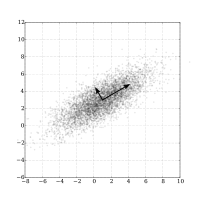
Photo from wikipedia
This paper presents a universal model of weighted coordinate transformation, i.e. transformation considering the errors of coordinates in both coordinate systems. It is intrinsically one of the typical examples of… Click to show full abstract
This paper presents a universal model of weighted coordinate transformation, i.e. transformation considering the errors of coordinates in both coordinate systems. It is intrinsically one of the typical examples of ‘error-in-variables’ (EIV) models. The proposed method of LS theory application on weighted coordinate transformation does not impose any constraints on the form of functional relationship among stochastic variables. Since the basic idea is to generalise Gauss–Markov model (GMM) by introduction of so-called ‘total residuals’, the proposed procedure is named ‘Generalised Gauss–Markov model’. Formulation of expressions for estimation of unknown transformation parameters is theoretically confirmed using the Gauss–Helmert model (GHM) and three different modifications of the GMM. The proposed procedure is in its essence a strict solution to total least-squares (unweighted) and weighted total least-squares problem in coordinate transformation. This thesis is experimentally confirmed by comparison of its results with those found in four characteristic examples from the literature.
Journal Title: Survey Review
Year Published: 2017
Link to full text (if available)
Share on Social Media: Sign Up to like & get
recommendations!